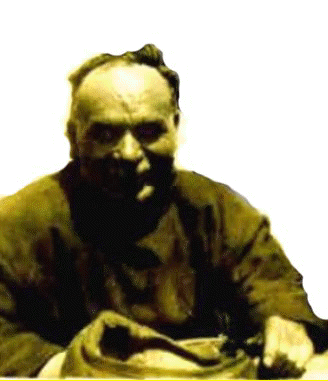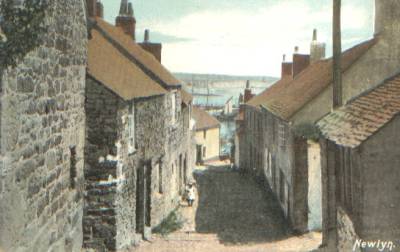
Home Page contents Family tree
Thomas Ellis Vingoe III

When visiting links from this site use your back button to return here
My Grandfather Thomas Ellis Vingoe III (Tom) was born in Newlyn, Cornwall on the 1st of November 1873, son of fisherman Thomas Ellis Vingoe II and his wife Harriet.
Thomas was born into a community which was morning the loss of so many lives through an outbreak of diphtheria. Even the local vicar, the Rev. J.P.Vibert, had been a victim. The vicar's death was a blow to the fishermen of Newlyn as he was a tireless worker on their behalf.
The first son of Thomas Ellis II and Harriet Vingoe, Thomas was born into a home where his older sisters Harriet aged 7 and Helena aged 5 were already attending the new Wesleyan Day School which was run by John Champion. The school was located at the top of Champion's slip named after the head master and which today is hidden away from view by what was once the canning factory. Ben Batten, a noted Newlyn Historian, wrote a book "Newlyn Heritage" published in 1980. In this book he has a chapter headed "Newlyn Wesleyan Day School" which I feel gives you the background to the life of Thomas growing up as a young boy in Newlyn. (Click here.)
 In 1881, Thomas and his family
were living at Prospect Place, Newlyn. In this photo of Trewarveneth Street the steps in the bottom left hand corner lead
into Prospect Place. The street is still there today and you can see a photo of
the house the family lived in HERE. Thomas's mother was Harriet Weeks
before she married and her family lived in the cottage at the bottom of the
street. By 1881 Thomas had two
Brothers, Robert and Richard Henry. The Census Return for that year shows the
family details as follows:.
In 1881, Thomas and his family
were living at Prospect Place, Newlyn. In this photo of Trewarveneth Street the steps in the bottom left hand corner lead
into Prospect Place. The street is still there today and you can see a photo of
the house the family lived in HERE. Thomas's mother was Harriet Weeks
before she married and her family lived in the cottage at the bottom of the
street. By 1881 Thomas had two
Brothers, Robert and Richard Henry. The Census Return for that year shows the
family details as follows:.
Thomas's two elder sisters do not appear on the return so were probably staying with relatives at the time the census was taken.
In 1885 at the age of twelve Thomas left school and went to work full time with his father. Now he had to get down to learning his trade as a fisherman. Seine fishing had ceased in Newlyn by 1883 so his father was probably engaged in one of two occupations. Pilchard driving, of which 24 boats were quoted as engaged in. or mackerel driving, in which 116 boats took part.
A drive was a group of boats & men who worked together, with a large net similar to a seine, to catch mackerel or pilchards. Outside of the Cornish pilchard and mackerel seasons they probably went further a field to catch their fish. Fishermen from Newlyn frequently went to Scotland and Ireland.
"Collectanea Cornubiensia" by George Clement Boase contains the following:-
"Richard Sinclair Brookes M.D. in his book "Recollections of the Irish Church" ... published in 1877, contains under the date of 1840:-
'Notices of John Kelynack, Henry Vingoe, Thomas James, (....who afterwards drowned), Nicholas Wright, Hitchens, Boyne and of Simmons (who died of consumption). These men were in Ireland fishing and Brooke held a service on board their boat at Kingston Harbour.' " The Henry Vingoe mentioned in this report was probably the great- uncle of Thomas.
There would, however, be times when Thomas and his father would be engaged in inshore fishing. He would have to learn the long held family secrets of where to find the best fish. In 1936 P Cowls of Porthleven gave an insight into these when he wrote an article on Longshoreman's Marks for the Old Cornwall Magazine.
Newlyn was a busy fishing port but lacked good facilities. In the year that Thomas left school a new harbour began to take shape when a ceremony to lay the foundation stone for a new pier took place on St Peter's Day. I wonder if there are any Vingoe faces in the photograph, could it be that the boy clinging to the woodwork on the right is Thomas? According to Ben Batten, many of the older fishermen were opposed to the extension of the old harbour, predicting [accurately as it happened] that it would bring in bigger boats from the east coast which would damage the fish stocks.
On the 1891 census the family were still living at Prospect Place shown as follows:
Name Position Status Age Birth place Occupation Thomas Ellis Head Married 48 Paul Parish Fisherman Harriet Wife Married 47 Paul Parish Annie Dau. Single 19 Paul Parish Domestic Servant Thomas Ellis III Son Single 17 Paul Parish Fisherman Robert Son Single 15 Paul Parish Fisherman Richard Henry Son Single 11 Paul Parish Scholar Emeline Dau. Single 9 Paul Parish Scholar Margaret Dau. Single 7 Paul Parish Lillian Dau. Single 6 Paul Parish Hugh Son Single 3 Paul ParishIn 1901 Penzance had a new lifeboat; a Lowestoft type W, which was powered by 12 oars with the addition of a sail. She had been named the "Elizabeth and Blanche" after the ladies who had donated the £753 it had cost to build her. She was 38' long and 9' 6'' in breadth and had been built in 1899 by Chambers & Colby of Lowestoft. I believe Thomas was often along side his Uncle Alfred Vingoe, who was pilot in Penzance and the coxswain of the boat. Alfred was only 3 years older than Thomas, due to his father marrying twice, and having a second family. On the Penzance boat Thomas honed the skills that would stand him in good stead when he became coxswain of the same boat when it was later moved to a station in Newlyn harbour in 1910.
The 1901 Census shows Thomas living with his parents at 7 Prospect Place, Newlyn.
Name Position Status Age Occupation Thos. Ellis Vingoe Head M 58 Fisherman (own account) Harriet Wife M 57 Harriet Dau U 35 Elizabeth Dau U 31 Thos. Ellis III Son U 27 Fisherman Robert Son U 25 Fisherman Richard Henry Son U 21 Stonemason Emeline Dau U 19 Tailoress Lillian Dau U 16 Dressmaker Hugh Son U 13On the 14th of July 1901 Thomas married Phyllis Samson at Paul Church. and took her to live at a new house which he had built by his uncle, John Weeks. Another Weeks relative was later to build the bungalow for my mother and father. Thomas 's house was at the top of St Peters Hill and they called it Penwith House. The house still stands with magnificent views across Mounts Bay. In 2001, however, the foundations were nearly washed away due to a collapse of an adit (underground passage for removing water from a mine) and the water company had to underpin the house and gardens. Hopefully, following this work, the house will stand for another hundred years.
Just after they were married, Thomas told Phyllis that he was determined to be the last fisherman in his line of the family. He had watched as hundreds from his village had moved abroad in search of a new life but he believed that Cornwall was the best place to bring up a family and, if it were done right, then they would have a chance to get out of the fishing. He shared the view that his father had had, that the bigger more powerful boats would lead to an end of the industry. This dream of my grandad's was to be fulfilled, in as much as none of his sons became fishermen. However, only one, my father, would remain in Cornwall and bring up his family and he was the last of the Newlyn Vingoe families to do so.
The first child of Thomas and Phyllis was a son born in 1902. They named him Thomas Ellis, so he became the fourth in line to carry the name. He was joined two years later by Richard Henry and in 1906 along came their daughter Phyllis.
1908 was a major year for my granddad, in that the Royal National Lifeboat Institute took the decision to move the lifeboat from Penzance to Newlyn. He was asked to take on the job of coxswain in place of Alfred. Within two months the boat and its crew were called on to rescue 20 men from the "Clan MacPherson of Glasgow and on the same day 28th December 1908 they were called out again to render assistance to the crew of the Schooner Titania of Salcombe.
Their next child born in 1909 was my father Robert (Bob) and, like his brother before him, he was named after one of his paternal uncles.
In the next three years Thomas and his crew would save 52 lives. The most notable rescue took place when the Norwegian Barque Saluto was wrecked in Mount's Bay. The Cornishman newspaper told the story at the time.
What the Newspaper did not report was the row that erupted over this rescue, a row that would lead to the men of Newlyn cutting their links to the lifeboat when it moved to Mousehole. Included in the crew that day were two brothers T.E.Vingoe & Robert Vingoe; a cousin 2nd Cox's. Arthur Vingoe. Also Bob Samson, who was T.E.Vingoe brother in law and Joe P Harvey and Billy Harvey who were his cousins. Others in the boat included Billy Roberts, B. M. Rouffignac, Nicholas Richards and Dick Mathews. I have not traced all the family connections within the wider sense but I remember my granddad telling me he could trust every last "man-jack" as they were all "family one way and another "
Indeed, the trust in each other was as valuable as that in their skipper. Most Penwith men do not follow blindly, they had to think and react as a team in certain situations. To a great extent this was influenced by their environment but was also contributed to by their hereditary traits. Altruism is not given to everyone, neither is courage, but the skill and power to take on the sea at her most terrifying and unforgiving must be "bred in the bone."
This helps to explain the father to son tradition and brother to brother rivalry for a place on the boat on a 'shout' and a wish to 'wear the jacket". Latterly, more than one member of the same family in the same boat was not allowed on a rescue but in the early days it was sometimes necessary. ~Men folk could be away with the fleet fishing and this had been the case with the "Saluto " rescue. However, in those days the crew of the boats were from small close- knit communities whose blood had mixed over centuries and who had also held strong bonds of friendship and dependence.
Any loss of life would be a tragedy to the village as a whole.
Return to Thomas Ellis Vingoe III on tree
![]()